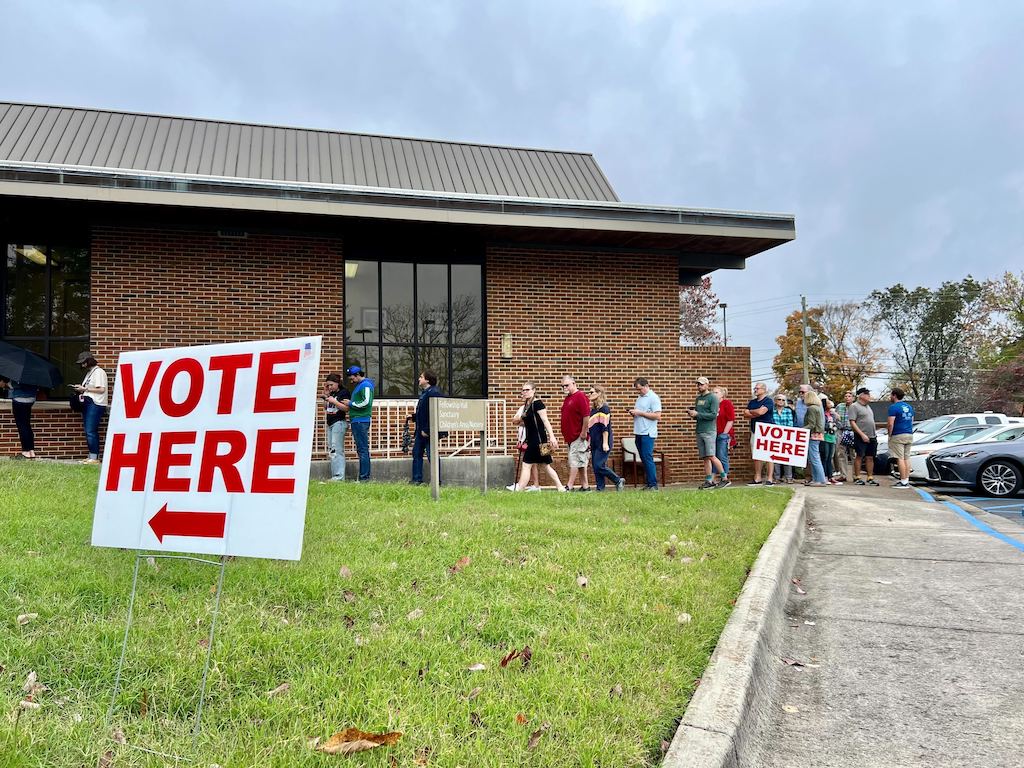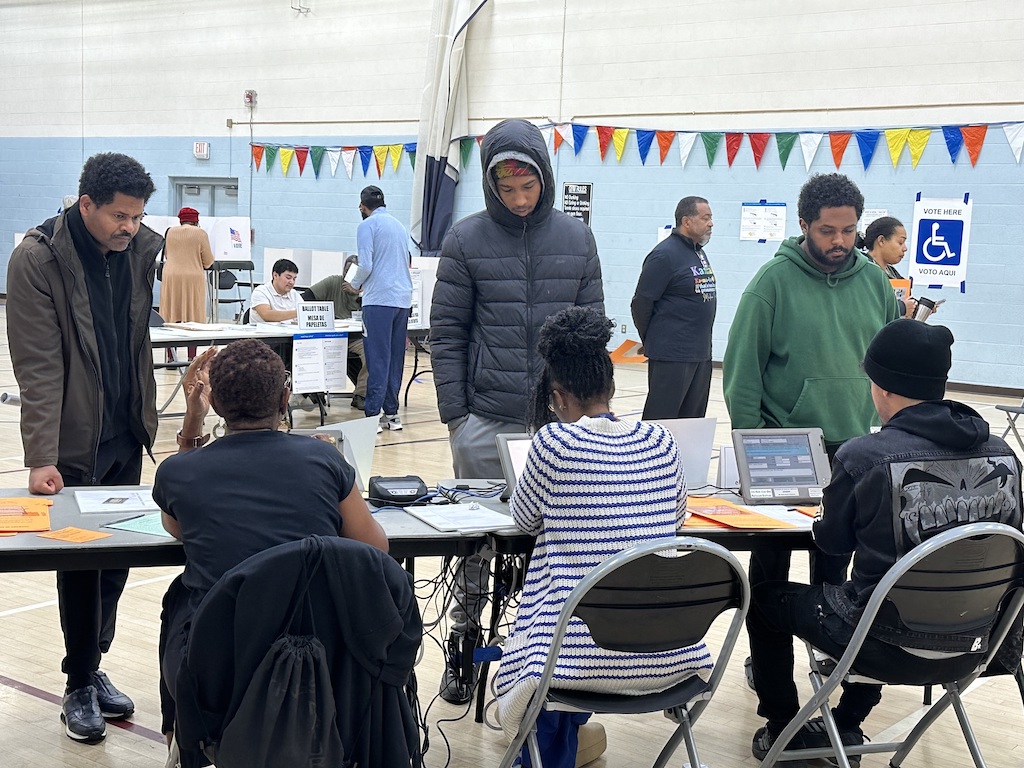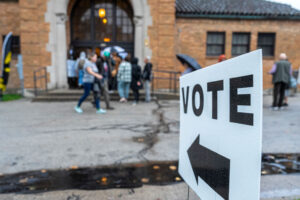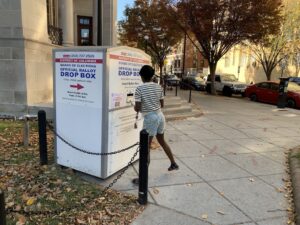5:00
News Story
After a bruising 4 years, a hope for normalcy in American elections
President-elect Donald Trump did not mention voter fraud in his victory speech.
America’s voting system was under siege for four years.
Former President Donald Trump’s false claims about fraud in the 2020 election exposed the people who operate our elections to threats and harassment in the run-up to this one. They fortified their offices against potential violence, adjusted to last-minute, politically driven changes in election laws, and fought a relentless stream of lies and disinformation. Going into Election Day, officials and pro-democracy advocates braced for the worst.
What a difference a day — and a result — makes.
Aside from a few hiccups, the U.S. voting process went smoothly this year. The winner of the presidential election was declared early the next morning, few people claimed widespread voter fraud, and the losing candidate conceded defeat.
It was a triumph for democracy, said David Becker, founder and executive director of the Center for Election Innovation & Research, a nonpartisan organization that advises local election officials nationwide.
But he wondered what would have happened had Trump, now president-elect, lost again.
“It’s somewhat telling that we’ve seen fewer fraud claims in the aftermath of an election which former president and future President Trump won,” he said. “But if we can get to the point now where President Trump and his supporters believe in the integrity of our elections, believe in the reality of our integrity of the elections, I will take it.”
Those who study the election process say they have questions: With Trump heading back to the White House, will faith in American democracy rebound? Will Republican lawmakers continue to use the myth of widespread voter fraud to implement further restrictions on mail-in and early voting? And will the threats that have hounded state and local election officials continue?
There’s a lot of uncertainty ahead for U.S. elections, said Kathy Boockvar, the former Democratic secretary of the commonwealth of Pennsylvania. But what is certain is that by fueling distrust in elections, Trump and his allies have done permanent damage in this country, she said.
“Will there be a bump, maybe, because some of these folks now saw their candidate that they wanted to win? Sure,” she told Stateline. “There may be a bump in trust, but it’s not going to erase years and years of intentional dividing American against American, and intentional fueling of distrust of institutions and media.”
What happened to the election fraud?
In his victory speech on Tuesday night, Trump said his win was “a massive victory for democracy.” He made no mention of widespread voter fraud and gave no indication that there were any attempts to steal the election.
He had struck a different tone just hours before.
Earlier in the day, Trump falsely asserted in a Truth Social post that there was a heavy law enforcement presence in Philadelphia and Detroit. Officials in both cities debunked that claim. He also claimed without evidence that there was “massive CHEATING” in Philadelphia, which local officials, including Republicans, denied.
Trump would go on to win the critical swing states of Michigan and Pennsylvania in his landslide victory.
What will it take to get belief in the trustworthiness of elections to a point where it’s true for all of us, all the time?
– Pamela Smith, president and CEO of Verified Voting
Election officials faced some falsehoods and disruptions Tuesday. Michigan officials called out what they said was an inauthentic video, allegedly showing boxes of ballots being carried into Detroit’s election office late Tuesday evening. The FBI warned of fabricated videos circulating online and of noncredible bomb threats at polling places in several states, including Michigan, originating out of Russia.
Michigan Secretary of State Jocelyn Benson, a Democrat, told reporters at a news conference Wednesday morning those incidents of disinformation felt like things she saw in 2020, as Trump and his allies began to contest his loss.
“I worry and imagine that there was much more planned to drop, potentially, to create confusion and chaos in the hours following the election in an effort to potentially lay seeds to challenge results in the future,” she said. “Of course, we didn’t see that play out.”
U.S. national security officials praised how elections were conducted nationwide this year, as they had in 2020. Jen Easterly, the director of the Cybersecurity and Infrastructure Security Agency, said the election was peaceful and secure, and that malicious activity had no significant impact on the integrity of the process.
‘Firehose’ of election conspiracy theories floods final days of the campaign
“Our election infrastructure has never been more secure and the election community never better prepared to deliver safe, secure, free, and fair elections for the American people,” she said in a press release Wednesday.
Election officials did a heroic job this year, said Pamela Smith, president and CEO of Verified Voting, a nonprofit that works with state and local election officials to keep voting systems secure. Officials’ work was built on years of beefing up election procedures, audits and security, and coordinating with nonprofit advisers. Elections are resilient, Smith said.
But she added: “What will it take to get belief in the trustworthiness of elections to a point where it’s true for all of us, all the time? And maybe that is a lofty goal, but it’s worth having.”
There are some challenges that need to be addressed, including long lines on college campuses, how to decrease the number of absentee ballots rejected over incorrect signatures, and how to address the continued threats from foreign bad actors such as Russia.
But the crisis of the past four years did force state and local election officials to be more prepared for all threats, said Boockvar, who is president of Athena Strategies and a member of the Committee for Safe and Secure Elections. The committee’s bipartisan group of election and law enforcement officials developed pocket-size guides to election laws for police officers to carry.
“The good news is we have much more cross-sector support,” she said.

Future legislation
After Trump cast his ballot on Election Day in Florida, he went to his campaign headquarters in Palm Beach and laid out what he wished the voting process looked like.
“They should do paper ballots, same-day voting, voter ID and be done,” he said. “One day, same day.”
In the tightest states, new voting laws could tip the outcome in November
The makeup of Congress is still unknown as local election offices continue to count ballots. But Republicans have shown a willingness to tackle federal voting legislation, as they did with their failed attempt to insert into a larger funding bill a ban on voting by noncitizens (which already is illegal).
But some of Trump’s ideas, especially moving the country to a system in which voters can only cast a ballot on Election Day, is unlikely, said Walter Olson, a senior fellow at the Cato Institute, a libertarian think tank. But other suggestions are possible, he added.
There is broad, bipartisan support among voters for mail-in and early voting, along with other protections such as voter list maintenance and audits, Olson said. For example, Georgia is a Republican-run state with robust early and mail-in voting and high voter turnout, with paper ballots, post-election audits and voter ID requirements.
Connecticut voters just approved a constitutional amendment that allows for no-excuse absentee voting. Nevada voters approved a ballot measure that now requires an ID to vote by mail and in person. Voters in eight states, including North Carolina and Wisconsin, also approved ballot measures to make noncitizen voting illegal under state law.
Republican state lawmakers still seem keen to continue finding new ways to tighten procedures in the name of “election integrity.”
This election ran smoothly because of the legislation and proactive lawsuits from the conservative movement, argued Arizona state Rep. Alexander Kolodin, a Republican who was sanctioned by the State Bar of Arizona for his role in challenging the 2020 election.
“Look, there were a lot of vulnerabilities still, but it was a more secure election than the ones we’ve had in the past,” he said in an interview.
Racist slurs and death threats: The dangerous life of a Georgia elections official
Kolodin introduced legislation this year to keep vote centers open longer and give voters more notice to fix signature or date errors on their absentee ballots, among other provisions. Democratic Gov. Katie Hobbs signed it in February.
He expects Trump to keep election integrity in the public consciousness and continue to pressure conservatives to work on it. For his part, Kolodin will push to scrap Arizona’s larger vote centers and opt for precinct-level polling places for better efficiency.
Before the election, Michigan state Rep. Luke Meerman, a Republican, told Stateline that he would love to see measures that require some sort of ID to vote in person and by mail.
“Something to prove that whoever filled that ballot out was the person that was supposed to be filling it out probably would be at the top of my list,” he said.
Despite Trump’s win, the false narratives around the supposed insecurity of U.S. elections — in which noncitizens and dead people are voting in droves — will likely continue, said the Cato Institute’s Olson; it is baked into the movement that brought the former president back into power.
“Given that so much of this was about Trump’s desire for personal vindication, maybe it’s over, and maybe we won’t face the same kind of systematic attempt to delegitimize the honesty of elections,” Olson said. “But that’s the optimistic view.”
YOU MAKE OUR WORK POSSIBLE.
Our stories may be republished online or in print under Creative Commons license CC BY-NC-ND 4.0. We ask that you edit only for style or to shorten, provide proper attribution and link to our website. AP and Getty images may not be republished. Please see our republishing guidelines for use of any other photos and graphics.






